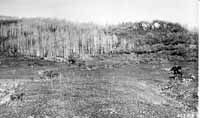| Historic photo of Cunningham Stomp in Colorado shows rangeland grasses depleted. H.P. Gaylor photo. |
Editor’s note: This article begins a series on rangeland health issues and cattle grazing
Range school was held in Moab for all interested farmers and ranchers in the three county area of Carbon, Emery and Grand. The Utah Range Coalition worked to bring the school to Utah. These schools have been started in Colorado with much success and are now being taught around Utah.
Roger Barton introduced the crew from Colorado and welcomed everyone to the school. He said the information to be presented will work and encouraged everyone to work together to improve the range. “The idea behind these schools is to build a relationship with the permittees and the agencies to preserve resources,” said Barton.
John Murray the range conservation officer for the Natural Resources Conservation Service from Montrose, Colo. was first on the agenda with a lesson on how grasses grow. “When soil temperatures reach 40-42 degrees in the spring grasses will begin growth from dormant buds or overwintering tillers. These buds are at the base of the plants that develop into tillers. Tillers are the shoots that develop from buds into a vegetative state or into seed stalk. Tillers have what are called growing points. Photosynthesis can only occur when the plant has leaf area. The photosynthesis process produces carbohydrates. Carbohydrates are pulled from root reserves to supply food to the growing plant. When leaves produce more than is used; it is stored for future use.
“The growing points are places where cells divide and elongate and this raises them above the ground. Early in the season these growing points control the plant. If the grass is grazed below the growing point then growth stops. If grass is grazed above the growing point then growth continues. Bud initiation drains carbohydrates and reserves stored in the roots. If it continues, a loss of vigor and root mass can occur. Different types of grasses grow differently, for instance, Kentucky bluegrass is slow to elongate and stays close to the ground. Western wheat grass elevates its growth point early and ends up in a vegetative state.
“To survive grass plants must accumulate both above and below the ground biomass. Healthy and large root systems are essential for extracting soil moisture. Grasses have a 30 percent annual dieout of root mass. If roots are unable to extract moisture and minerals from the soil, this will limit growth and food production for storage. The above ground biomass supports the root system and food storage reserves and the below ground biomass supports the food producing factory,” said Murray.
| Cunningham Stomp now known as Round Corral Park in Colorado shows dramatic regrowth when compared with the historic photo above. It is now managed in a seven pasture deferred rotation, photo taken by Dave Bradford, U.S. Forest Service Range Officer. |
Murray presented a slide show of the lifecycle of grasses for a year. In Nov.-Feb. root buds are forming; March and April show rapid root growth; May and June the plant is using reserves; July and August, roots are extending and September and October fall regrowth occurs.
Murray said with the drought situation they had dug up plants which had lost a lot of root mass; which they can get back. Murray stressed the need for the grasses to have the opportunity for regrowth in the fall. Dormant buds for the coming year are formed in late summer and early fall. Fall regrowth is important for growth in root carbohydrate for bud initiation in the spring. Over wintering tillers break out with buds earlier in the spring.
“The more dormant buds the grass plant produces, the more grazing tolerant it becomes with faster regrowth. A plant is never really dormant, the plants are still alive and using their food storage to survive; they are not growing, but maintaining,” said Murray. Frost is a major killer of early growth in a plant and can set the whole growth process back by weeks, or even stop it altogether. Drought situations produce a lack of growth in a plant and not as many dormant buds are produced. These factors lessen the amount of the plant available to grow resulting in inferior plant regrowth and lessened root mass.
Murray suggested that with understanding of how plants grow and the effects of drought on plants, a grazing system can be developed to the benefit of the grass. Grazing shouldn’t take place at the same time every year on the same ground. A grazing system must include time for growth and regrowth sometime during the year.
Heavy grazing throughout the season is usually the least desirable grazing strategy.
A management strategy which incorporates rest period and movement of animals through different pastures is more desirable for grass growth.

